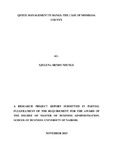Queue Management in Banks: the Case of Mombasa County
| dc.contributor.author | Njuguna Henry N | |
| dc.date.accessioned | 2013-11-26T08:55:11Z | |
| dc.date.available | 2013-11-26T08:55:11Z | |
| dc.date.issued | 2013 | |
| dc.identifier.uri | http://erepository.uonbi.ac.ke:8080/xmlui/handle/123456789/60399 | |
| dc.description.abstract | The aim of this research project was to study queue management of banks in Mombasa County using the Multi-channel queue model. The study population composed of all the 108 bank branches and the basic data was collected using observational timing of customer entry and service over a period of 2 hours. The number of branches successfully studied was 20 translating to 18.5% of the branch coverage. In terms of the number of institutions 15 banks out of 37 operating in the County were successfully accessed during data collection implying 41% of bank coverage. The total number of branches visited was 48 out of 108 representing 44.4% of the total population .Out of 48 branches visited the successful response of 20 represents 42% of those visited. The raw data was then analyzed using Excel template bearing the multichannel queue model equations. In general, most banks exercise multichannel queue system with 19 of 20 banks having more than one queue. The exceptional bank is unique because its core transaction is remittance of funds from Arabian Diaspora and its Forex service for those seeking opportunities there. Interestingly the service rate for this bank is commendable at 1.3 minutes per customer calling for need for congested banks to consider systematic segregation of services for instance; dedication of counters for deposit or withdrawals only so that the teller is properly tuned. The average service rates ranges from 0.3 and 1.3 customers per minute (0.8 to 3.3 minutes per customer).The mean service rate across banks is 0.8 Customers/Min (1.3min/customer) whereas the standard deviation is 0.3 Customers/minute . Banks with heavy queue formation tend to have faster service compared with those that are scanty due to less work pressure on the tellers. Bank management in less busy banks need to review need to increase customer base to utilize the less busy tellers. The mean waiting time in the system for the County is an efficient 27 minutes compared with that of earlier studies of between 55 and 64 minutes. A lot of sensitization will need to be carried out to improve response rate of study institutions in the future by involving other industry stakeholders like KBA and CBK. In a number of banks sufficient information on service offered at specific counters should be availed to customers to reduce waiting time in the banking halls. It will involve a lot of resources and cooperation of study institutions to carry out simultaneous data collection in all 108 branches in the County in order to even out the study environment. | en |
| dc.language.iso | en | en |
| dc.publisher | University of Nairobi, | |
| dc.title | Queue Management in Banks: the Case of Mombasa County | en |
| dc.type | Thesis | en |
| local.publisher | School of Business | en |

